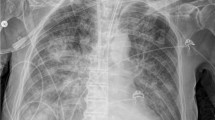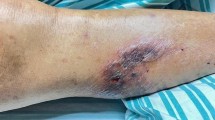Abstract
Background
In humans, Pasteurella multocida infections are usually limited to the soft tissues surrounding a lesion. However, P. multocida can also cause systemic infections (such as pneumonia, lung abscess, peritonitis, endocarditis, meningitis and sepsis)—especially in patients with other underlying medical conditions.
Case presentation
We report on a case of fulminant P. multocida bacteremia at several sites (soft tissues, endocarditis and joints) on a white European man. Despite surgery and intensive medical care, the patient died.
Conclusions
The present case emphasizes the importance of appropriate initial treatment of skin wounds. Patients at risk should be aware of the possible consequences of being bitten, scratched or licked by their pet.
Similar content being viewed by others
Background
The facultative anaerobe Pasteurella multocida is a fermentative, Gram-negative coccobacillus often found in the upper respiratory tracts of healthy fowls and domesticated species (especially cats and dogs) [1]. It can cause infections in humans, usually as a result of being scratched, bitten or licked by cat or dog. In the present report, we describe a fatal case of P. multocida-induced endocarditis and joints in a white European patient with several comorbidities (Additional file 1).
Case presentation
A 74-year-old man was admitted to hospital for septic shock. He had been suffering from fever, weakness, and erysipelas of the right leg for the previous month. He mentioned that his pet dog had licked a skin wound, and had received two courses of antibiotics (amoxicillin + clavulanic acid). The comorbidities including atrial fibrillation, hypertension, venous leg ulcers, obesity, alcoholism and aortic valve stenosis. The patient had undergone total right knee joint replacement 1 year previously.
On admission, the patient presented with fever (38.1°C), hypotension (80/50 mmHg) and a known systolic aortic murmur. He had an elevated leukocyte count (13 × 109 L−1), high C-reactive protein (340 mg L−1, N value <5) and procalcitonin (11 μg L−1, N value <0.5) levels and mild renal impairment (creatinine clearance: 32 ml min−1, serum creatinine: 181 µmol L−1, serum urea: 21 mmol L−1). Urine and blood cultures were sent to the microbiology lab. Fluid resuscitation and empirical antibiotic treatment therapy (with piperacillin + tazobactam) were initiated.
The patient rapidly developed septic shock, acute kidney injury and hyperlactatemia (7.2 mmol L−1, N value <1.6). Two peripheral blood cultures were positive for wild-type P. multocida. Isolates presented a sensibility to beta lactams, fluoroquinolones and cyclines, a resistance to lincosamides and to aminoglycosides and a decreased sensibility to macrolides. The urine sample was negative. Computed tomography (CT) and Magnetic Resonance Imaging (MRI) of the right leg (Figure 1) revealed cellulitis over the lower half of the tibia, many small fluid collections but no damage around the prosthetic knee joint. These abscesses were evacuated surgically on the day of admission, and were also positive for P. multocida. The piperacillin + tazobactam treatment was then replaced by ampicillin (8 g/day) and doxycycline (200 mg/day).
On day 3, the patient’s renal function had improved and norepinephrine was withdrawn.
Septic shock recurred on day four. Transthoracic echocardiography revealed intense mitral regurgitation and a left ventricular fraction ejection of 55%. Subsequent transesophageal echocardiography evidenced mobility of the small cusp of the mitral valve (Figure 2), severe mitral regurgitation, and holosystolic flow reversal in the left ventricle. Together with the patient’s blood culture results, these findings along were consistent with mitral valve endocarditis (as defined by Duke’s criteria) [2].
The patient became confused and disoriented. The results of a lumbar puncture (Cerebrospinal fluid analysis) and a brain CT scan were normal. A whole-body CT scan revealed multiple abscesses on both legs, with knee joint effusions (Figure 3). With a view to treating the infection around the prosthetic knee joint, we performed right arthrotomy and synovectomy, together with irrigation and debridement of the rest of the legs. Treatment with piperacillin + tazobactam was reintroduced and supplemented with a course of vancomycin-ciprofloxacin-amikacin.
On day 6, the patient developed treatment-refractory shock with multiple organ failure and disseminated intravascular coagulation. Despite vacuum-assisted closure, the right leg became increasing necrotic—prompting removal of the prosthetic knee joint on day 7. During surgery, the patient suffered a cardiac arrest and died despite our attempts at resuscitation.
Discussion
There are many literature reports of P. multocida infections in humans. These are mainly local infections and cellulitis, although subsequent necrotizing soft tissue infections have also been reported. Oral and/or respiratory tract infections can occur in immunocompromised patients (due to diabetes mellitus, liver cirrhosis, cancer, etc.). Severe, invasive infections (such as meningitis, endocarditis, arthritis, intra-abdominal infections [3]) are less frequently described.
Although the present case did not have known liver dysfunction, he was alcoholic and presented with a dysmorphic liver on a CT scan, an elevated gamma-glutamyl transferase level and an elevated mean corpuscular volume.
Endocarditis is a rare complication of P. multocida sepsis [4, 5]. A review of the literature revealed a total of 34 cases, 28 of which involved native valves (13 mitral, 12 aortic, 1 pulmonary, 1 tricuspid and 1 unspecified). Only 9 cases required surgical treatment in addition to antibiotics. The outcome was fatal in 12 cases (i.e. 35% of the total). The case described here was particular in that severe bacteremia was present at several foci in cardiac, skin and joint tissue. We tried to preserve the prosthetic knee joint by combining debridement and synovectomy with intravenous antibiotics (in accordance with current guidelines) [6] but the treatment was unsuccessful. Some researchers have suggested to exchange the interspace using an antibiotic-coated component [7]. The same researchers noted that of the cases of P. multocida-related arthroplasty infections presented in the last decade, 62.5% had the prosthesis removed [7].
One unusual feature of the present case was the long time interval between the initial wound and hospitalization. Previous reports have described either a hematogenous infection after a scratch or bite at a remote site or reactivation of previous infection [8]. Despite surgical excision and effective antibiotic therapy, secondary endocarditis and joint infection occurred in our patient.
Pasteurella species are generally susceptible to several antibiotics. Penicillin is considered to be the drug of choice, although fluoroquinolones, second and third-generation cephalosporins, and carbapenem are also suitably active against Pasteurella [9]. In the present case, appropriate antibiotic treatment did not enable us to rush out the infection—probably because of the multiple foci and simultaneous organ damage induced by the bacteria.
Conclusions
In conclusion, P. multocida infection following a poorly disinfected dog or cat bites can lead to multifocal bacteremia and a high risk of mortality. Early wound assessment (including antibiotic treatment when required) is very important in cases of animal bites, scratches or licks.
Consent
Written informed consent was obtained from the patient’s wife for publication of this case report and accompanying images. A copy of the written consent is available for review by the Editor-in-Chief of this journal.
Abbreviations
- CT:
-
computed tomography
- MRI:
-
magnetic resonance imaging
- N value:
-
normal value
- P. multocida :
-
Pasteurella multocida
References
Khan MF, Movahed MR, Jung J (2012) Pasteurella multocida endocarditis. J Heart Valve Dis 21:260–262
Habib G, Hoen B, Tornos P, Thuny F, Prendergast B, Vilacosta I et al (2009) Guidelines on the prevention, diagnosis, and treatment of infective endocarditis (new version 2009): the Task Force on the Prevention, Diagnosis, and Treatment of Infective Endocarditis of the European Society of Cardiology (ESC). Europ Heart J 30:2369–2413
Hazouard E, Ferrandiere M, Lanotte P, La Marcis L, Cattier M, Giniès G (2000) Septic shock caused by Pasteurella multocida in alcoholic patients Probable contamination of leg ulcers by the saliva of the domestic cats. Press Med. 29:1455–1457
Mikaberidz N, Li EY, Taub CC (2013) Pasteurella multocida infective endocarditis in an immunocompetent patient complicated by rhabdomyolysis and permanent hearing loss. J Cardiovas Dis Res 4:55–57
Naba MR, Araj GF, Kanafani ZA, Kanj SS (2009) First case of Pasteurella multocida endocarditis of the tricuspid valve: a favorable outcome following medical treatment. Int J Infect Dis 13(5):267–269
Lortat-Jacob A, Desplaces N, Gaudias J, Dacquet V, Dupon M, Carsenti H et al (2002) Tiresias group. Infection secondaire de prothèse articulaire: critères du diagnostic, traitement et prévention. Rev Chir Orthop 88:51–61
Heydemann J, Heydemann JS, Antony S (2010) Acute infection of total knee arthroplasty caused by Pasteurella multocida: a case report and a comprehensive review of the literature in the last 10 years. J Infect Dis 14(Suppl 3):242–245
Subramanian B, Holloway E, Townsend R, Sutton P (2013) Infected total knee arthroplasty due to postoperative wound contamination with Pasteurella multocida. BMJ case Rep. doi:10.1136/bcr-2013-009973
Goldstein EJ, Citron DM, Merriam CV, Warren YA, Tyrell KL, Fermandez HT (2002) In vitro activities of garenoxacin (BMS-284756) against 170 clinical isolates of nine Pasteurella species. Antimicrob Agents Chemother 46:3068–3070
Authors' contributions
MG participated in data acquisition and analyses, and wrote the manuscript. EZ, HD and AHH participated in data acquisition, data analyses, and preparation of the manuscript. KK, LF, AMGR, FT, and MM participated in the data analyses and drafting of the manuscript. All authors read and approved the final manuscript.
Acknowledgements
We thank Marie Trujillo, Pierre Huette and Stéphane Bar for their participation in the acquisition of the data, and David Fraser for revision of the manuscript.
Funding
Performance of the present work did not require a specific grant from any funding agency in the public, commercial or not-for-profit sectors. The Department of Anesthesiology and Critical Care Medicine had no role in the study design, data collection, analysis and interpretation, the writing of the manuscript, and the decision to submit the manuscript for publication.
Compliance with ethical guidelines
Competing interests The authors declare that they have no competing interests.
Author information
Authors and Affiliations
Corresponding author
Additional file
Additional file 1:
CARE Checklist (2013) of information to include when writing a case report.
Rights and permissions
Open Access This article is distributed under the terms of the Creative Commons Attribution 4.0 International License (http://creativecommons.org/licenses/by/4.0/), which permits unrestricted use, distribution, and reproduction in any medium, provided you give appropriate credit to the original author(s) and the source, provide a link to the Creative Commons license, and indicate if changes were made. The Creative Commons Public Domain Dedication waiver (http://creativecommons.org/publicdomain/zero/1.0/) applies to the data made available in this article, unless otherwise stated.
About this article
Cite this article
Guilbart, M., Zogheib, E., Hchikat, A.H. et al. Fatal multifocal Pasteurella multocida infection: a case report. BMC Res Notes 8, 287 (2015). https://doi.org/10.1186/s13104-015-1232-7
Received:
Accepted:
Published:
DOI: https://doi.org/10.1186/s13104-015-1232-7







